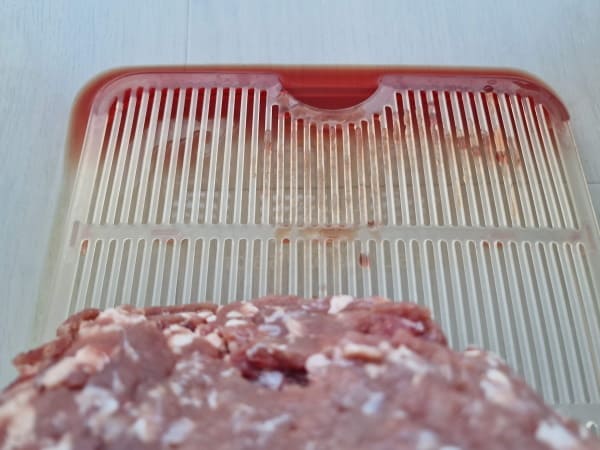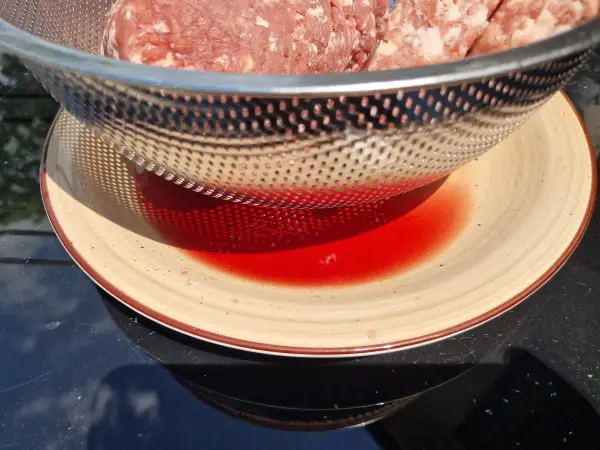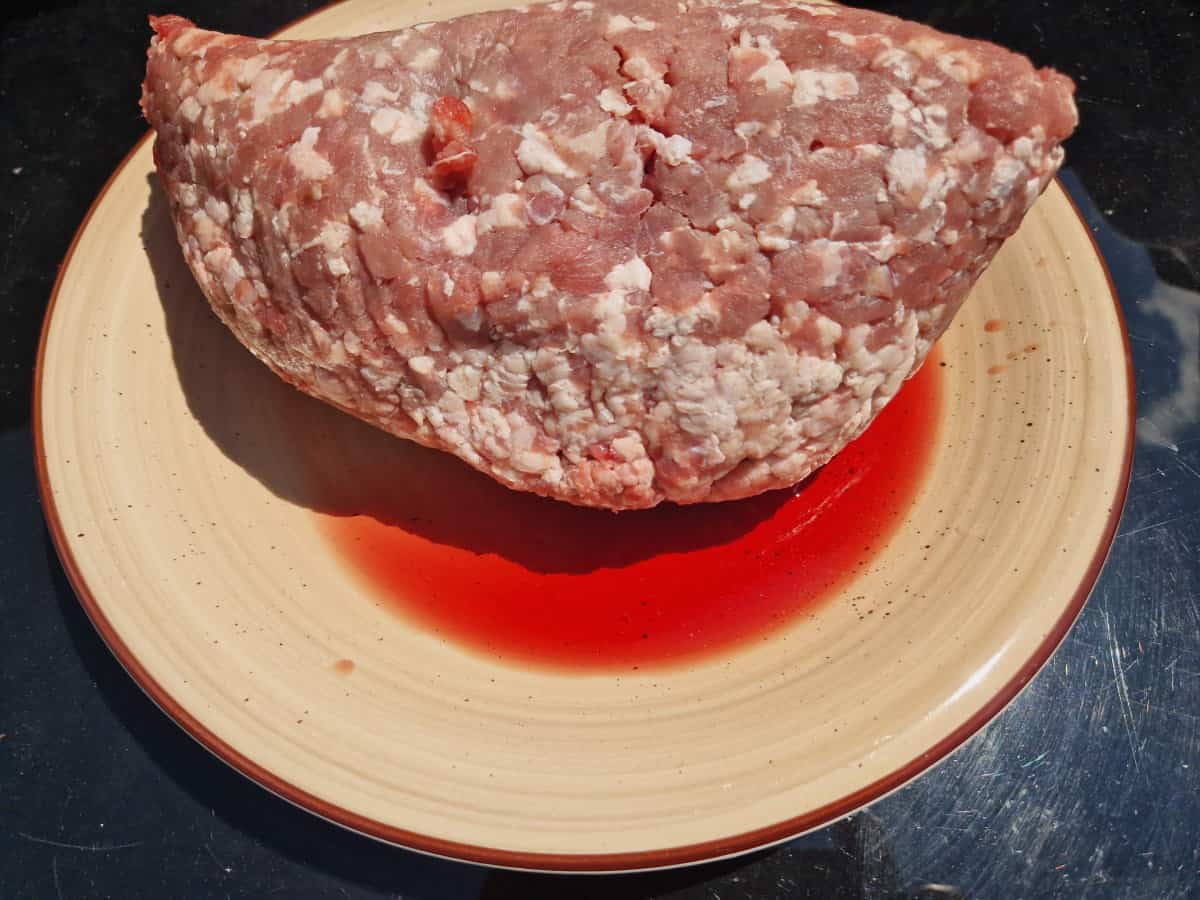There’s a term that is often used in the culinary world to describe the process of thawing meat and how the meat looses juices during this process. It’s called the purge.
And while the juices appear to be reddish in color, you may be wondering if it is in fact blood, or something else?
Another pertinent question you should be considering is whether this purge can be avoided and what it means in terms of nutrients and flavor.
Juices released from meat during the thawing process are in fact ice crystals that have formed inside the fibers of the meat. When the meat thaws, these fibers tear and leak out essential nutrients known as myyoglobin, which give the water that red tint. This can be avoided by flash freezing the meat, deoxidizing the meat, or using the correct thawing methods.
What is the blood that comes out of meat?
The first matter to address is the liquid that leaks out of thawing meat.
Like me, you may have thawed meat on the countertop before (this is not recommended). You should always adhere to safe defrosting methods. And, during the thawing process, you may have noticed a lot of red juice leaking from your meat, making you wonder: Is it really blood that comes out of raw meat?
The answer is: not exactly. There is a common misconception that the juice that leaks out of meat is blood.
When meat is cut or handled, or as it ages, it tends to release a red or dark liquid. This is the result of the proteins in the meat losing its ability to hold on to the water stored in the fibers of the meat. And, when the meat is unable to hold the water in, nutrients are released with the water.
Since most of the meat releases juices in the thawing process, you should always separate the meat from them. The best way to separate the meat from juices that are formed in the thawing process is to use different kitchen utensils. I usually use a colander or a plastic Lock & Lock container with a draining tray.


By using these utensils you can easily separate meat from juices.
Can you cook meat with the red juices that leak out?
It is safe to both consume and cook with this red liquid.
In fact, the red liquid is very rich in nutrients and contains a lot of protein content. Furthermore, the amount of red liquid will depend on a few factors, such as the amount of time the meat was stored and the temperature at which it was stored. As well as the packaging and the method by which the meat is defrosted.
Why does blood or juices come out of thawed meat?
You’ll be forgiven for thinking that the liquid at the bottom of your meat package is blood. After all, it not only looks like blood, but, similar to blood, may even have an iron smell to it.
But, as previously stated, it is, in fact, not blood. On the contrary, it is a very nutrient-rich liquid.
Freezing meat is a great way to store meat for later use. It allows consumers to purchase meat in bulk and store it at 0° F (-18° C). However, when meat is frozen, it undergoes a specific process.
When meat is frozen, sharp crystals form in the fibers of the meat, causing these fibers to swell up. When the meat is thawed, these fibers tear and release the liquid inside.
In addition to releasing the melting ice crystals, the meat also releases a lot of the nutrients stored within the fibers of the meat. One such nutrient is a red protein called myoglobin. The myoglobin contains haem. The haem stores and carries oxygen in its muscle cells. When the ice crystals melt, the myoglobin is released along with the liquid, giving it its distinct red hue.
An interesting point about myoglobin is that when it is cooked it darkens. This is why your steak transforms from a bright red to a brownish tint when it is cooked well done.
What is the red liquid in meat packages
No, that red liquid at the bottom of your meat package is not blood. It is a mixture of water and myoglobin that leaks into the packaging diaper. And, as previously mentioned, it is perfectly safe to cook with the rest of your meat.
How to thaw meat without losing juice
Ideally, you want to keep as much of that red liquid inside the meat before, during, and after the cooking process.
But the dilemma is: how can you achieve this?
It’s quite simple. There are various methods that you can employ to ensure that the nutrients stay inside the meat.
Employ the correct thawing method
There are three methods to correctly thaw meat and prevent the loss of essential nutrients, and ultimately, the flavor of the meat. The first is to slowly thaw the meat overnight in the refrigerator. This should prevent most of the liquid from escaping from the meat.
Alternatively, you could thaw the meat in a bowl with cold water and allow it to sit until the meat is properly thawed. Replace the water every 30 minutes to prevent the meat from forming bacteria.
The last method is in the microwave by properly defrosting the meat. The key to using the microwave is that the meat should be cooked immediately and should never be placed back in the freezer or refrigerator directly after it has been thawed.
Be sure to set the microwave to defrost, or alternatively, set the microwave to a reduced power setting. You want to thaw the meat in the microwave, not cook it.
Flash freeze the meat
Flash freezing will allow you to quickly freeze your meat and also to keep the ice crystals as small as possible. To flash freeze meat you will need the following items:
- One-third cup of water
- Half a cup of salt
- A pound of ice
Mix the ingredients together and place the sealed meat inside the water mixture. Allow to sit for up to three hours. This strategy will not eliminate ice crystals but it will ensure that they are much smaller in size and ultimately result in less purge during the thawing process.
Deoxididing
The key to preserving meat is to remove as much air from the bag before sealing it. The oxygen is detrimental to the state of the meat. It will cause discoloration, it will diminish any smell, and prevent freezer burn.
Put the meat inside a freezer-safe Ziploc bag. Place the bag in water which will push most of the air out of the bag as you create a natural suction. The method will also help to reduce the purge of red meat juices.
Should you wash juices or blood off thawed meat
It’s important to note that in the past this may have been necessary. In the past, this was done to remove any slime, dirt, or fat that may have been stuck to the surface of the skin. But as time and technology have improved, this is no longer required.
Meat products and poultry are cleaned during the processing phase. So there is no need for you to wash the meat or poultry before preparing it.
One of the main reasons that this practice is no longer in effect is the fact that there are bacteria in raw meat, poultry, fish, and pork. When you wash the meat products, you are essentially spreading this bacteria in other food items, utensils, and even surfaces.

